We’ve ridden Royal Enfield’s new Himalayan in its intended namesake environment, but what’s it like in Australian conditions?
Talk about an unexpected flashback! As I throw my leg over the latest Himalayan 450, Royal Enfield’s do-it-all adventure bike, I am instantly transported from outer Melbourne carpark to upper India mountain pass. It is truly a transition from the suburban to the sublime.
The feel of the bike underneath me is just so familiar, so evocative, that I am taken straight back to 2018, which was the last time I rode a Himalayan… fittingly, in the Indian Himalayas. And it was a decent ride too – many days of high-altitude culture shock, with some of the most amazing mountain roads and mind-bending views you could imagine. It was magic and I fell in love with the Himalayan during the trip, as it felt like the perfect steed for the conditions. Which, of course, has always been the point of the Himalayan project.
What I didn’t know back then was that a small army of test mules for the next model were already racking up some serious miles in all kinds of conditions in the UK, Spain and India. More than five years later, the new Himalayan has finally been unveiled, having gone through an exhaustive design and testing program. This complex approach was adopted because, as the design team puts it, “the Himalayan is not a styling exercise; it is more of a tool”. In other words it’s a multi-function pocketknife of a machine created to cater to a variety of rider styles and abilities in a vast range of conditions.
While we have already tested the Himalayan 450 in the Himalayas, this is our first ride of the bike in Australia.
It’s quickly apparent that the look and feel of the new bike are very similar to the original, despite the fact that the two versions differ in so many ways. Clearly, the brief was to retain the unmistakable essence of the Himalayan while improving all its elements to create a familiar yet all-round better bike.
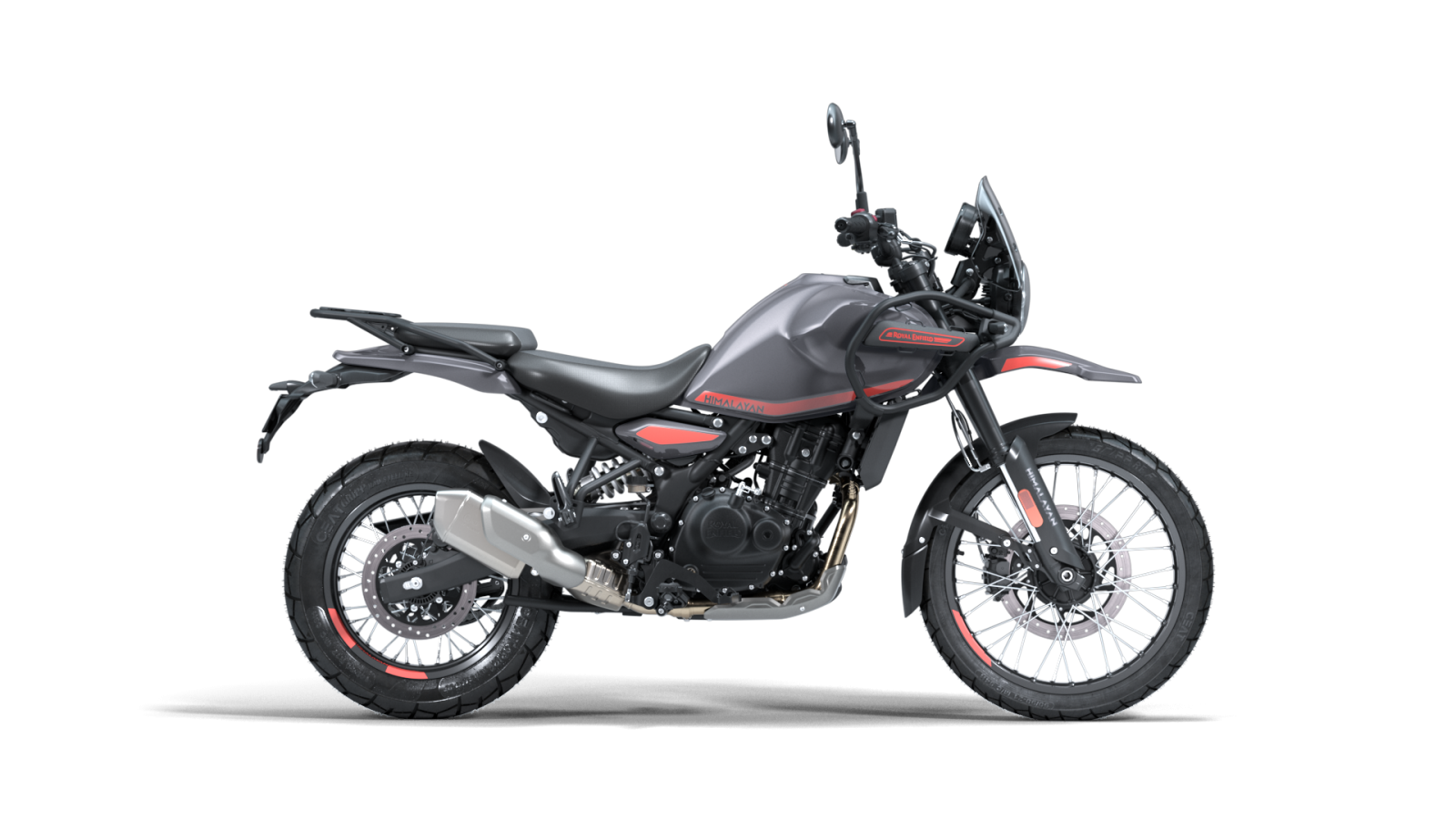
So, my first question is answered before I even hit the road. Is the new model of this much-loved motorcycle anything like the original? It most certainly feels like a very close relative. The DNA is unquestionably the same, despite the fact that it has been totally redesigned.
My second question is answered soon after, as we head down the freeway out of the city, heading to the Victorian High Country for the Aussie launch of the new Himalayan. Is it more suited to local conditions, particularly in the grunt department? One thing the original model desperately needed was more power to allow it to deal with long-haul, highway-speed touring. And also to cope with very high altitudes where the thin air robs engines of a large percentage of their power output. The move from 411cc air-cooled engine to a totally new 450 liquid-cooled powerplant has achieved all that while remaining LAMS approved.
The new single-cylinder, which has a fittingly mountainy moniker – the Sherpa 450 – is Royal Enfield’s first water-cooled engine. The boffins at RE HQ decided the benefits of liquid-cooled technology far outweighed the negatives (such as added complexity and, of course, a radiator that might cop a stone or two). It’s hard to disagree once you ride the bike. The new engine is a huge step up from the previous unit and makes a world of difference to the bike’s performance and desirability. Furthermore, all manufacturers need a liquid-cooled donk in their arsenal these days, as emissions legislation gets tougher every year. Prepare to see many more water-cooled Royal Enfield models in the future.

Expect this new water-cooled single-cylinder engine to appear across future models in the Royal Enfield range
The Sherpa 450 is also an impressive 10kg lighter than LS410 it replaces, while creating almost 40 percent more power than the old engine (29.4kW [39hp] compared to 18kW [24hp]). It is also a stressed member of the tubular steel frame and has been inclined forward to lower the centre of gravity. With its four-valve head, dual overhead cams and a short-stroke design, the 452cc single also produces 40Nm of torque at 5500rpm, which is almost 70 percent more at 7000rpm than the old long-stroke engine.
This all means that freeway speeds are easily achieved and maintained, without screaming revs and uncomfortable vibrations. And I’m thrilled to discover that there’s an extra gear, a sixth ‘overdrive’ (plus a slip-and-assist clutch), to keep things cruisy at higher velocities.
The new model feels so much more at home on the highway and continues to impress as we press on up into the hills on sweeping country roads. Such a welcome improvement and one that I feel will win this model many new fans.
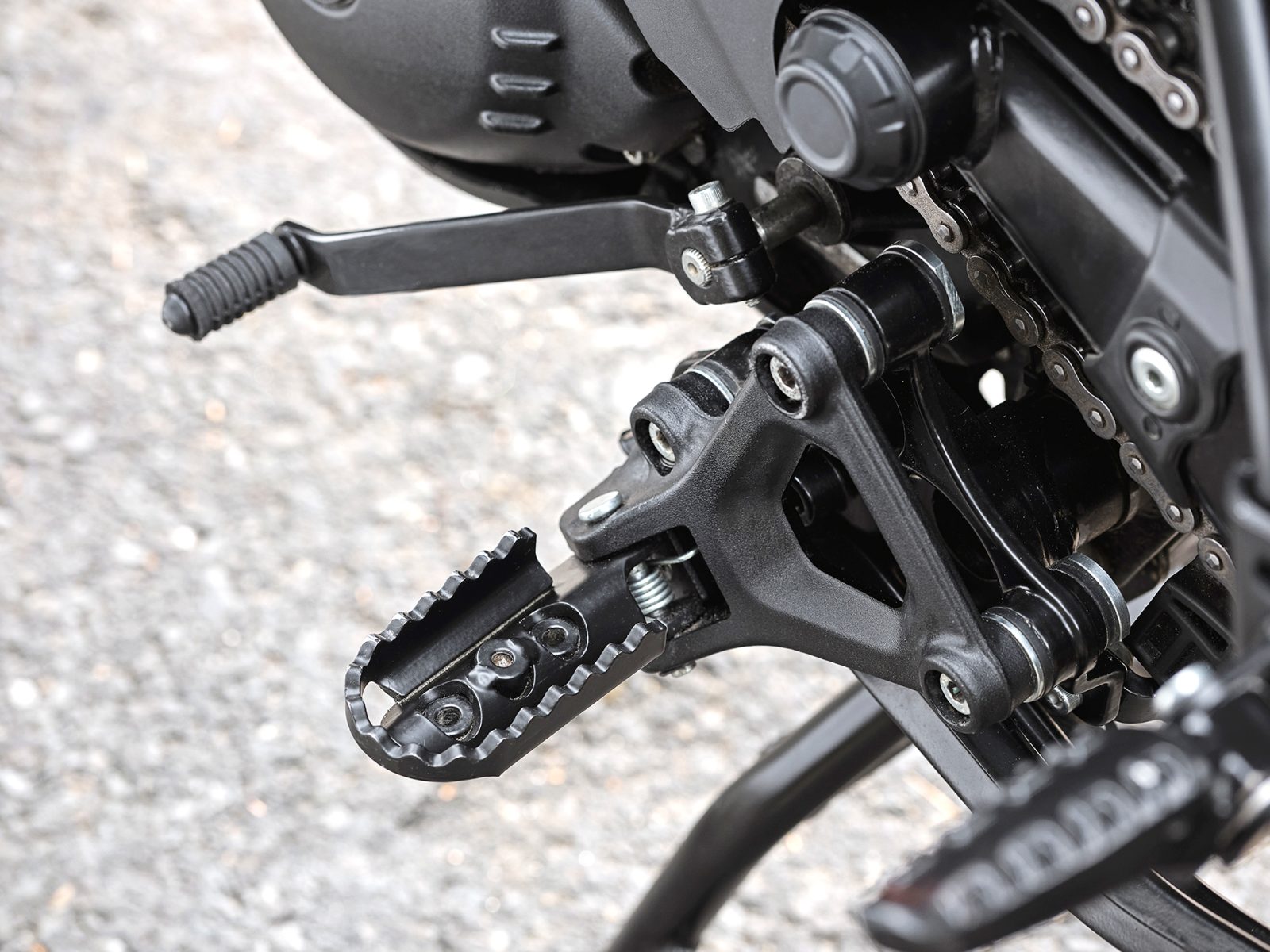
Rubber inserts can be removed from footpegs for off-road work
Perhaps one downside is that the new engine and gearing means that the low-end torque pull of the original has been reduced, so that more revs are needed at low speeds. The old Himalayan’s ability to bobble along in first gear at crawling speed without stalling has disappeared, which was one element of the old bike that many appreciated. It’s not a huge problem; it just requires a recalibration of rider inputs if you are used to the previous model’s characteristics.
In the days to follow, other elements of the new Himalayan’s design will come to the fore. For example, front suspension duties are now performed by an upside-down separate-function Showa fork, enabling 200mm of wheel travel and resulting in a remarkably predictable and precise feel at the front end. There’s no adjustment up front, and the rear monoshock is a simple adjustable-preload affair, but it’s all such a big upgrade from the original model that you feel the difference straight away, on and off the road. It’s worth noting that the new lay-down rear shock and compact linkage system keeps everything high and out of harm’s way, which is an advantage when it comes to off-road duties, as does the extra 30mm of ground clearance over the previous model.
It is interesting to hear so many comments from riders surprised at the how remarkably planted the Himalayan feels on the road for a ‘small’ bike. The front suspension upgrade is definitely a factor, as is its almost 200kg mass (no aluminium or carbon fibre here).
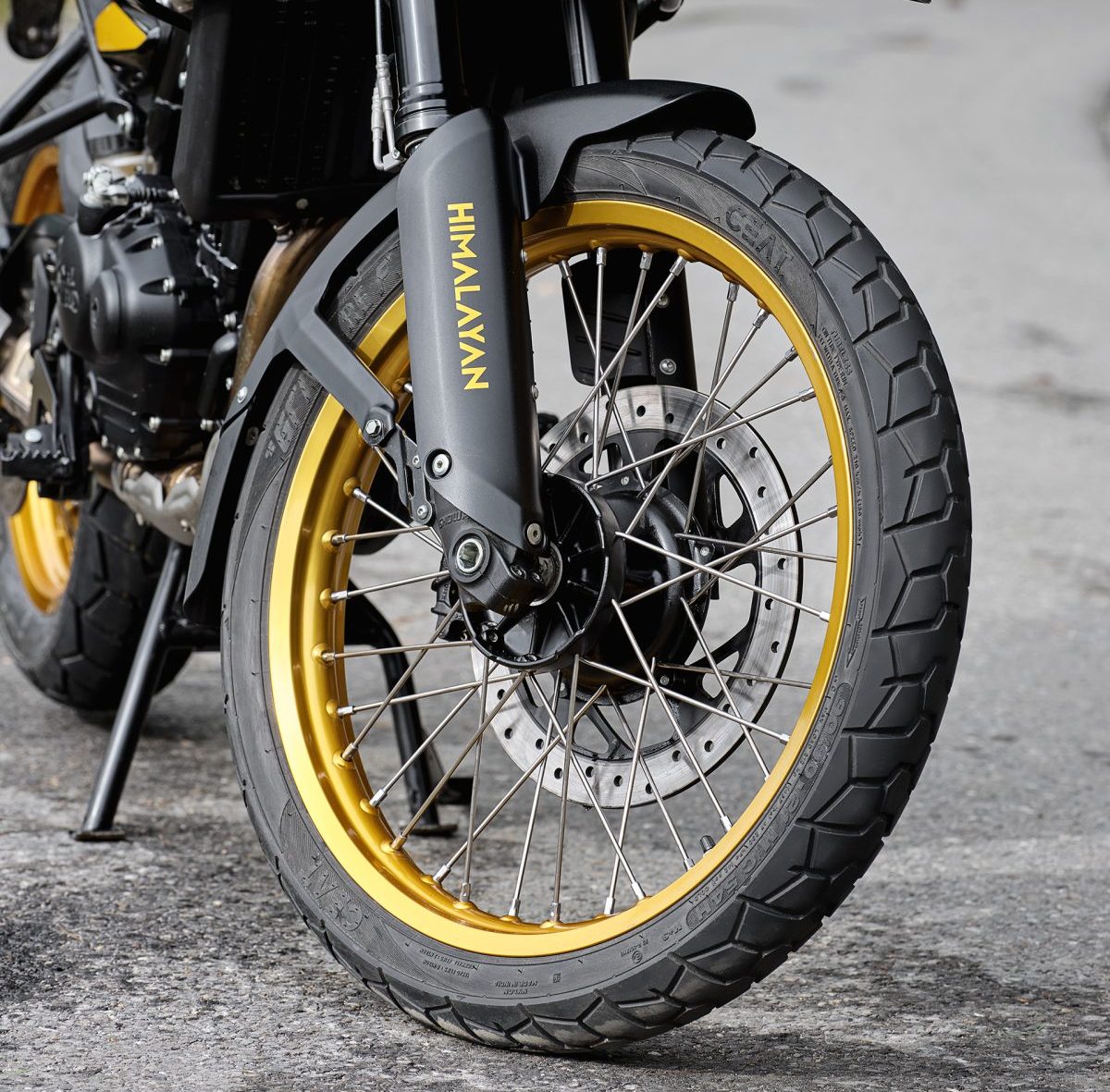
Spoked wheels contain tubes but there is another version coming that is tubeless
The on-road performance is surprisingly good, and some spirited alpine riding really bears this out. Some initial hesitancy about the quality of the CEAT Gripp Rad Steel RE tyres (made in India specifically for the Himalayan) disappears when it becomes clear that the whole package is set up well for road riding. Saying that, I get the feeling that a tyre upgrade (better off-roaders if dirt is your game or stickier rubber for the twisties) would probably be a good move, at least once the OE tyres wear out.
Talking about off-road usage, the launch ride (led by Aussie motorcycle legend Cameron Donald) allows the bikes to be tested on some truly gnarly (and often very steep) territory. Despite the inevitable bangs and bumps in such conditions, all the bikes (and riders) come out of it still fully operational (although yours truly got a bit battered and bruised). This is one of the great attractions of the Himalayan – it is strong, simple and capable, engendering confidence when riding in almost all terrain and with most damage able to be hammered out or bent back into shape. Usability has also been increased with such tweaks as a relocation of the air intake from under the seat to the top of the engine to help keep the airbox cleaner and farther away from water during river crossings. The fuel tank has grown by two litres (allowing Royal Enfield to quote an optimistic fuel range of 450km) but is mounted lower, while the catalytic converter sits down low behind the gearbox, allowing for a smaller silencer to be fitted. The new anti-vibration footpeg mounts are also appreciated when you remove the rubber inserts from the ’pegs for some serious off-road action.
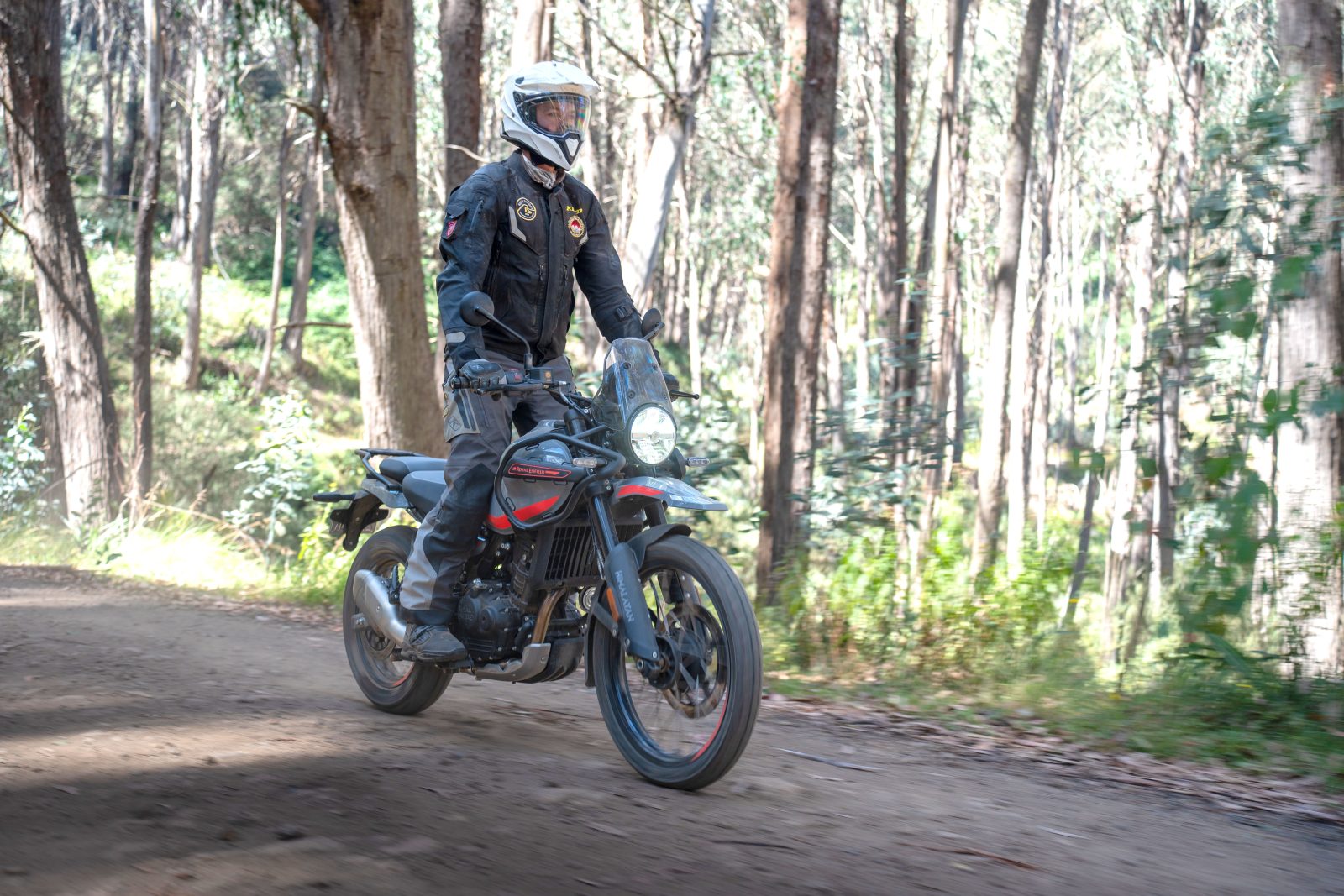
Royal Enfield claims that a narrower centre package allows for easier standing and that the handlebar is better positioned for both sitting and standing. To be honest, it is hard to know how much difference these tweaks make without having an older model to jump straight onto, but the new model felt great, just as the original did. Even at 188cm, I didn’t feel too tall for the Himalayan, with its upright riding style and wide ’bar – and, with four seat heights ranging from 825mm to 845mm, there should be a setting to suit almost everyone.
While we’re discussing dimensions, the wheels are still 21-inch front and 17-inch rear, which really does feel ideal for the intended usage of the Himalayan. The wheels are spoked but one interesting element to keep in mind is that the top-spec Kamet White model, which should be available in Australia by mid-year, will be fitted with more robust tubeless spoked wheels.
Many Aussie riders will no doubt feel that this is the best option for them, both for tractability and ease of repair.
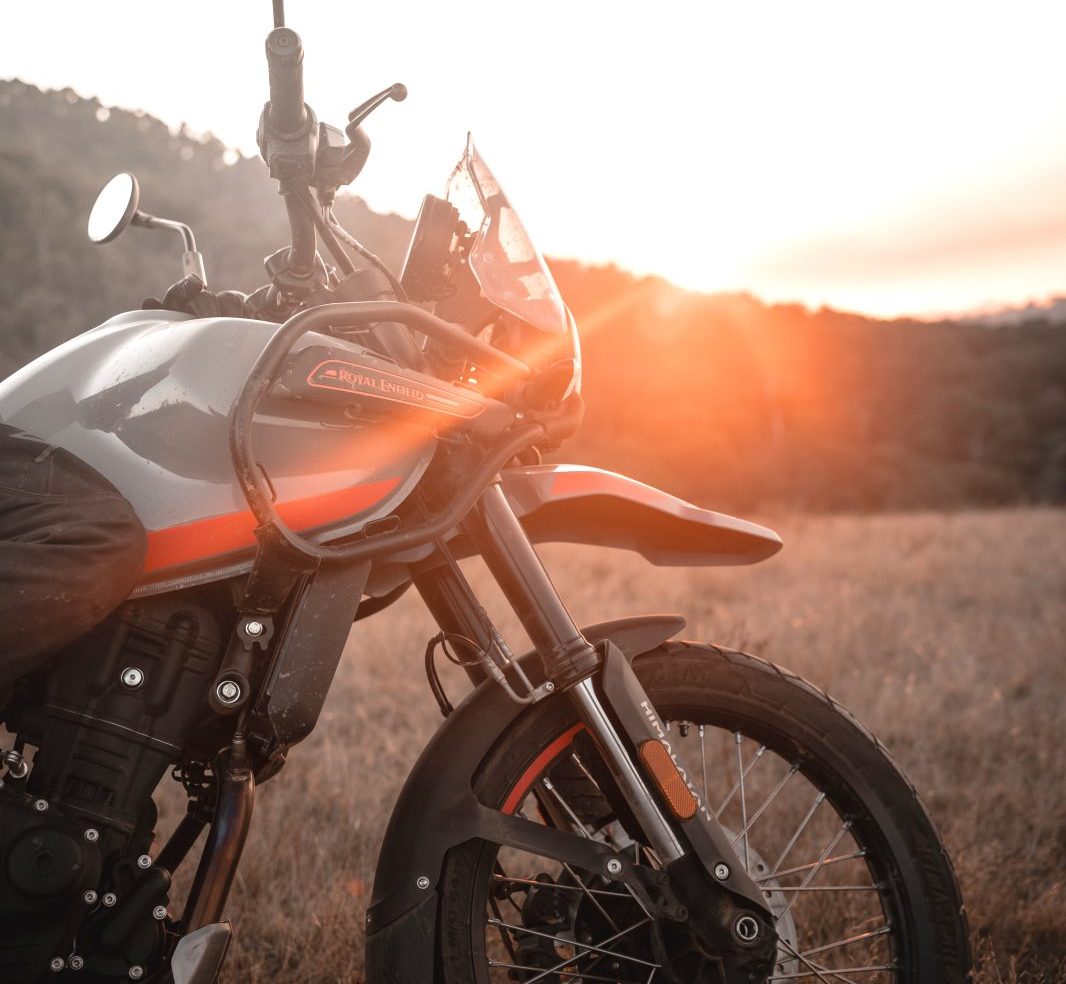
Cockpit mounted crash bars are a standard Himalayan feature
Performing stopping duties on these wheels are Bybre brakes (‘By Brembo’, a brand dedicated to small-to-medium displacement motorcycles and scooters) with a twin-piston caliper and single disc up front and a single-piston caliper at the rear. The brakes are a definite improvement on the originals, which could get a bit spongy, although I can’t help but feel twin discs up front wouldn’t be the worst move. Then again, the Himalayan is all about simplicity, practicality and affordability, so there is nothing ‘extra’ on this machine. And you can’t argue against the fact you get a whole lot of bike for less than $9,000.
There is also a two-mode ABS. On the road both wheels get full ABS, while off-road intervention is reduced on the front wheel and is completely turned off on the rear. There’s no traction control but there are two rider modes, which is a first for the now ride-by-wire Himalayan. You have the choice of Performance with ABS on, Performance with rear ABS off, Eco with ABS on and Eco with rear ABS off. Ride modes can be switched on the fly, while ABS can only be changed while stopped. Performance with ABS turned off is definitely the only choice once the tarmac stops.

Modern TFT display still manages to capture the rugged workhorse vibe of the Himalayan
There’s more new unexpected but appreciated tech on the Himalayan too – namely the ‘Tripper’ system. This is a four-inch TFT display with phone connectivity, media controls and map navigation, with a joystick control for music, calls and messages via a paired smartphone. The dash offers a choice of analogue or digital screens, with an ambient light sensor for day and night modes. Available information includes digital speedo and tacho, fuel gauge, clock, gear indicator, rider modes and ambient temperature. It’s all pretty compact and simple and is definitely a user friendly addition.
Indeed, user friendliness is central to the Himalayan. It’s an affordable, functional and, dare I say, loveable bike that I feel will continue to win over sceptics while satisfying existing fans with its simplicity and versatility.
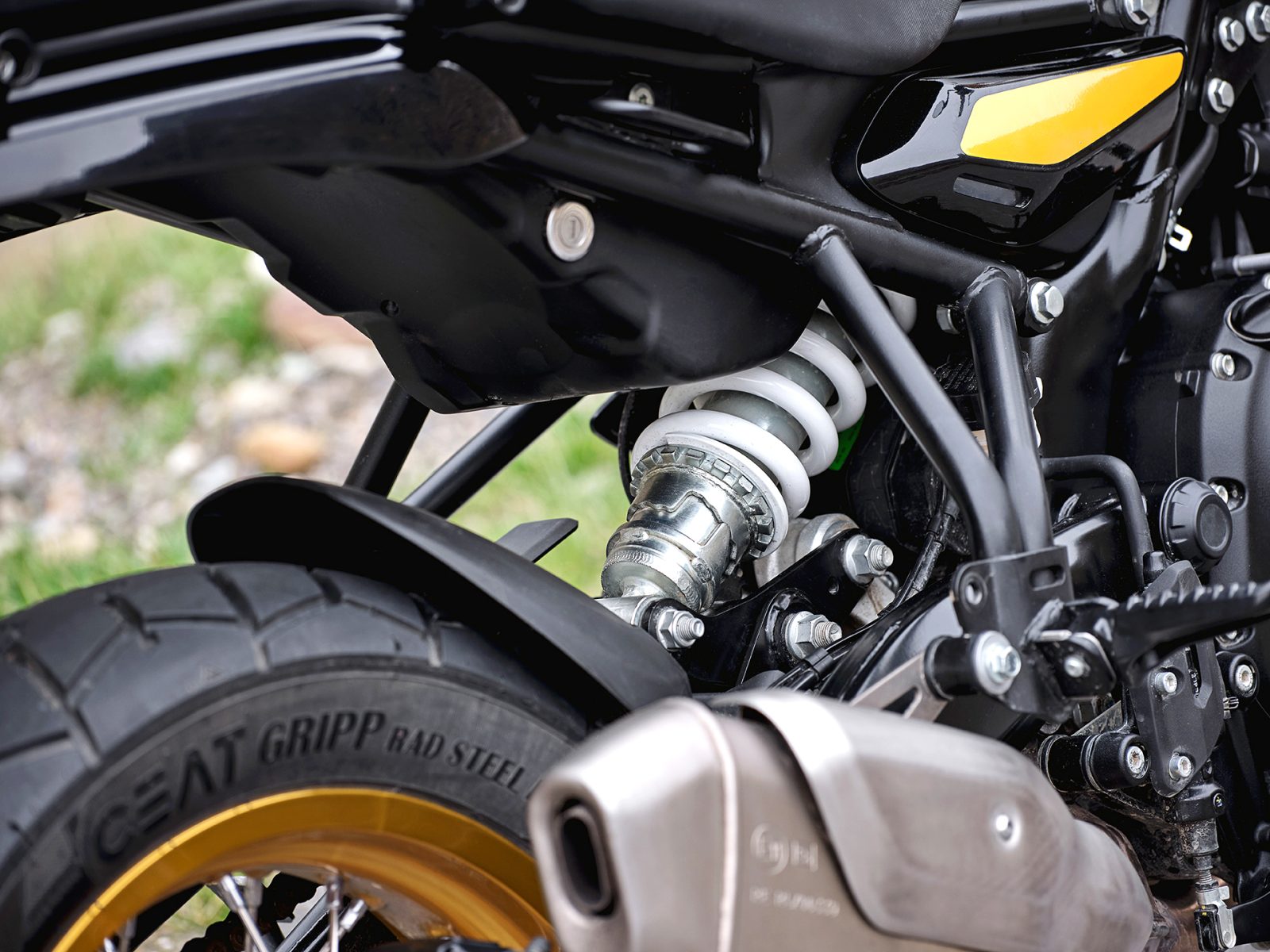
Rear monoshock is a big improvement on the previous Himalayan model
PROS: Solid, honest and capable machine that has improved in almost every way from the already good original.
CONS: New engine is less comfortable at super low speeds and small standard screen doesn’t offer a great deal of protection.
TEST: SEAN MOONEY PHOTOGRAPHY: TOM FOSSATI
SPECS
ENGINE
Capacity 452cc
Type Single-cylinder, DOHC, four valves
Bore & stroke 84 x 81.5mm
Compression ratio 11.5:1
Cooling Liquid
Fueling EFI, 42mm throttle body
Transmission Six-speed
Clutch Wet, multi-plate, slipper type
Final drive Chain
PERFORMANCE
Power 29.4kW (39.4hp) @ 8000rpm (claimed)
Torque 40Nm @ 5500rpm (claimed)
Top speed 160km/h (est)
Fuel consumption 3.7L/100km (claimed)
ELECTRONICS
Type Bosch
Rider aids Two-mode ABS
Rider modes Sport and Eco
CHASSIS
Frame material Tubular steel
Frame type Twin spar
Rake Not given
Trail Not given
Wheelbase 1510mm
suspension
Type Showa
Front: 43mm upside-down separate-function fork, non-adjustable, 200mm travel
Rear: Monoshock, preload adjustable, 200mm travel
WHEELS & BRAKES
Wheels Wire spoked
Front: 21 x 2.15 Rear: 17 x 4.25
Tyres CEAT Gripp Rad Steel RE
Front: 90/90-21 (54H)
Rear: 140/80-17 (69H)
Brakes ByBre, ABS
Front: Single 320mm disc, twin-piston caliper
Rear: Single 270mm disc, single-piston caliper
DIMENSIONS
Weight 198kg (kerb, claimed)
Seat height 825-845mm
Width 852mm
Height 1316mm
Length 2245mm
Ground clearance 230mm
Fuel capacity 17L
SERVICING & WARRANTY
Servicing First: 1000km
Minor: 10,000km
Major: 20,000km
Warranty Three years, unlimited kilometres + three years roadside assist
BUSINESS END
Price From $8990 (ride away)
Colour options Hanle black, Kamet white, Slate Himalayan Salt, Slate Poppy blue, Kaza brown
Contact www.royalenfield.com.au